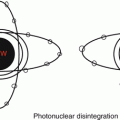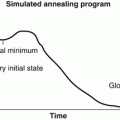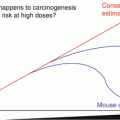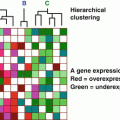, Foster D. Lasley2, Indra J. Das2, Marc S. Mendonca2 and Joseph R. Dynlacht2
(1)
Department of Radiation Oncology, CHRISTUS St. Patrick Regional Cancer Center, Lake Charles, LA, USA
(2)
Department of Radiation Oncology, Indiana University School of Medicine, Indianapolis, IN, USA
Oxygen Effect
Why?
Oxygen Fixation Hypothesis:
Ionizing Radiation creates ion pairs in water.
Note that this is a form of indirect action.
Direct action creates ion pairs in DNA, and is unaffected by oxygen.
Within nanoseconds: Ion pairs in water react with molecules to form free radicals. (R·).
Within microseconds: Free radicals are eliminated by sulfhydryl-containing free radical scavengers, such as glutathione (GSH).
Oxygen reacts with free radicals in DNA to form peroxides (ROO·) which cannot be easily repaired.
This is known as “oxygen fixation” (Fig. 22.1).
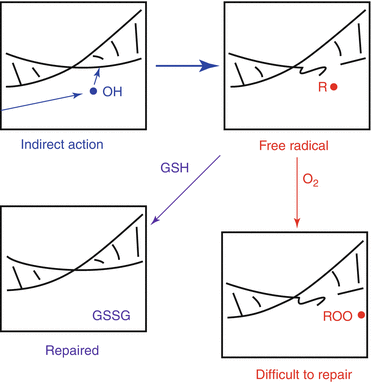
Fig. 22.1
The oxygen fixation hypothesis. Free radicals are easily repaired by antioxidants, but molecular oxygen can convert them into peroxides that are more difficult to repair.
Oxygen increases indirect effects of ionizing radiation if it is present during or within microseconds after irradiation.
It does not matter what the oxygen concentration is seconds pre- or post-irradiation.
Therefore, transient hypoxia is a big deal! See Chapt. 23 for details.
How Much Oxygen Is Needed for the Oxygen Effect?
The Oxygen Effect operates at very low concentrations of O2:
0.001 % O 2 (0.008 mmHg): Fully anoxic, no oxygen effect.
0.5 % O 2 (4 mmHg): Half oxygen effect.
2 % O 2 (16 mmHg): Full oxygen effect, no significant difference with further increase of O2.
Oxygen levels for comparison:
0.13 % O 2 (1 mmHg): Fully hypoxic tissue.
2–5 % O 2 (20–40 mmHg): Venous blood.
8–13 % O 2 (60–100 mmHg): Arterial blood.
20 % O 2 (150 mmHg): Room air.
100 % O 2 (760 mmHg): Pure oxygen.
Note that normal tissue should not be hypoxic!
Even the lowest oxygen tensions in a living human are well above what is needed for full oxygen effect.
Therefore, hypoxia protects tumors, it does not protect normal tissues.
See Chapt. 23 for a detailed discussion of hypoxia in tumors.
Stay updated, free articles. Join our Telegram channel

Full access? Get Clinical Tree


